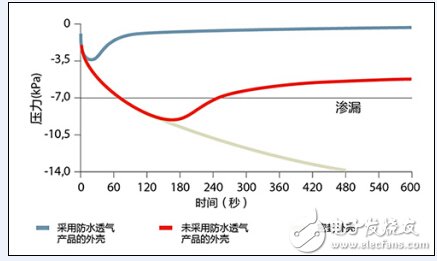As more and more mechanical components are replaced by electronic components and the popularity of driver assistance systems, the number of electronic components in automobiles is rapidly increasing. This trend has put more pressure on automakers and their suppliers to find effective ways to protect their electronic components from contamination and seal failure. Ensuring that these electronic components operate reliably over the life of the vehicle is a primary goal, not only to increase cost efficiency, but also to promote the brand's high quality image and reliability. All electronic components, whether compressors, pumps, motors, control units, or sensors of the increasingly popular active safety system, are subject to large temperature fluctuations throughout their life. This occurs when the component housing heats up during vehicle operation and comes into contact with low temperature sputtered water or car wash water on the road surface. This temperature fluctuation creates a significant vacuum effect within the electronics housing. The resulting large differential pressure can severely damage the seals and seals that protect sensitive electronic equipment, causing ingress of dirt particles and liquids, corroding electronic components and shortening their service life. Damaged or defective parts must often be replaced, which increases the warranty and repair costs of the car manufacturer and its suppliers. Challenges in electronics and batteries in electric vehicles A major challenge for the automotive industry is temperature management of high-performance electronics and batteries in electric vehicles, because these components need to operate over a range of temperatures for optimum performance. These components become very hot during operation and require liquid cooling. However, this causes a large temperature difference inside the electronic device, and condensation forms at the lowest temperature point on the outer casing, causing corrosion or short circuit. This problem is very common for large battery cases, and it is difficult to solve this problem if no effective measures are taken to balance temperature and pressure. Due to the size of the outer casing, even a small temperature difference creates sufficient pressure on the outer casing to cause it to deform. In some cases, when the vehicle exits from a higher temperature garage and enters a cold open air environment, a vacuum is created inside the casing, creating a negative pressure of 500 kilograms per square meter. The thin and light casing can hardly withstand such high pressure. Breathable membrane technology to deal with: to achieve a balance of air and pressure Original equipment manufacturers (OEMs) typically have three ways to address this challenge. The first is to potting electronic components. Although this solution results in a perfect sealing system, it also significantly increases the weight of the unit and cannot be reopened for repair in the event of a failure; another method of forming a secure sealing system is the use of high quality seals and thick outer walls. However, the disadvantage of such a system is that it increases component costs and increases unnecessary weight. A more reasonable common solution is to use a gas permeable membrane that balances the air in the enclosure while also preventing the ingress of liquids and dirt particles. Figure 1 The process of continuous accumulation of negative pressure in a sealed enclosure Figure 1 shows the process of continuous accumulation of negative pressure in a sealed enclosure. On a casing that is not waterproof and ventilated, after several cycles of temperature cycling, a pressure of only 7 kPa is sufficient to cause the seal to fail. The outer casing of the waterproof and breathable product balances the pressure and prevents the seal from leaking. Blade Fuse is a kind of current fuse, when the circuit current exceeds the fuse rated current of 2 times in a few seconds when the fuse will play the role of circuit protection. Widely used in equipment circuit protection standard for foreign and domestic automobiles and trucks. Readily identifiable and easily replaced, this fuse can be specified for a variety of low voltage electronic Applications. Harness Component Dongguan YAC Electric Co,. LTD. , https://www.yacentercns.com